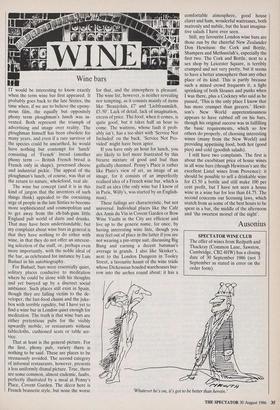Wine bars
IT would be interesting to know exactly when the term wine bar first appeared. It probably goes back to the late Sixties, the time when, if we are to believe the epony- mous film, the equally but oppositely phony term ploughman's lunch was in- vented. Both represent the triumph of advertising and image over reality. The ploughman himself has been obsolete for many years, and even if a rare survivor of the species could be unearthed, he would have nothing but contempt for 'lunch' consisting of 'French' bread (another phony term — British French bread is French only in shape), processed cheese and industrial pickle. The appeal of the ploughman's lunch, of course, was that of the return to nature, wholefood, real ale.
The wine bar concept (and it is in this kind of jargon that the inventors of such things think) appealed to the coexisting urge of people in the late Sixties to become more sophisticated and cosmopolitan and to get away from the eh-bah-gum little England pub world of darts and drunks. That may have been understandable, but my complaint about wine bars in general is that they have nothing to do either with wine, in that they do not offer an interest- ing selection of the stuff, or, perhaps even more importantly, with the noble ideal of the bar, as celebrated for instance by Luis Butluel in his autobiography.
For Bufittel, bars were essentially quiet, solitary places conducive to meditation where he could be alone with his thoughts and yet buoyed up by a discreet social ambiance. Such places still exist in Spain, though they are falling victim to the de- veloper, the fast-food chains and the juke- box with terrible rapidity, but I have yet to find a wine bar in London quiet enough for meditation. The truth is that wine bars are either pretentious pubs for the visibly upwardly mobile, or restaurants without tablecloths, cushioned seats or table ser- vice.
That at least is the general picture. For the first, phony pub, variety there is nothing to be said. These are places to be strenuously avoided. The second category of informal restaurants, however, presents a less uniformly dismal picture. True, there are some common, almost endemic, faults, perfectly illustrated by a meal at Penny's Place, Covent Garden. The decor here is French brasserie style, but none the worse
for that, and the atmosphere is pleasant. The wine list, however, is neither revealing nor tempting, as it consists mainly of items like 'Beaujolais, £7' and `Liebfraumilch, £5.50'. Lack of detail, lack of imagination, excess of price. The food, when it comes, is quite good, but it takes half an hour to come. The waitress, whose fault it prob- ably isn't, has a tee-shirt with 'Service Not Included' on the back. 'Service Not Pro- vided' might have been apter.
If you have only an hour for lunch, you are likely to feel more frustrated by this bizarre mixture of good and bad than gallicaily charmed. Penny's Place is rather like Plato's view of art, an image of an image, for it consists of an imperfectly realised idea of a French wine bar, which is itself an idea (the only wine bar I know of in Paris, Willy's, was started by an English- man).
These failings are characteristic, but not universal. Individual places like the Cafe des Amis du Vin in Covent Garden or Bow Wine Vaults in the City are efficient and live up to the generic name, for once, by having interesting wine lists, though you may feel out of place in the latter if you are not wearing a pin-stripe suit, discussing Big Bang and earning a decent batsman's average in grands. I also like Skinker's, next to the London Dungeon in Tooley Street, a favourite haunt of the wine trade whose Dickensian bonded warehouses bur- row into the arches round about: it has a
`Whatever he's on, it's got to be better than heroin.'
comfortable atmosphere, good house claret and ham, wonderful waitresses, both matronly and nubile, but the least imagina- tive salads I have ever seen.
Still, my favourite London wine bars are those run by the cheerful New Zealander Don Hewitson: the Cork and Bottle, Shampers and Methuselah's, especially the first two. The Cork and Bottle, next to a sex shop by Leicester Square, is terribly cramped and not very pretty, but it seems to have a better atmosphere than any other place of its kind. This is partly because such a mixed crowd frequents it, a light sprinking of both Sloanes and punks when I was there, plus a Cockney who said as he passed, 'This is the only place I know that has more crumpet than geezers.' Hewit- son's New World unpretentiousness appears to have rubbed off on his bars, though his original success was in fulfilling the basic requirements, which so few others do properly, of choosing interesting wines (many from the New World) and providing appetising food, both hot (good pies) and cold (goodish salads).
I still have two complaints. The first is about the exorbitant price of house wines in all wine bars (though Hewitson's are the excellent Listel wines from Provence): it should be possible to sell a drinkable wine for £150 a bottle and still make 100 per cent profit, but I have not seen a house wine in a wine bar for less than £4.75. The second concerns our licensing laws, which snatch from us some of the best hours to be spent in a bar, the middle of the afternoon and 'the sweetest morsel of the night'.
Ausonius








































 Previous page
Previous page